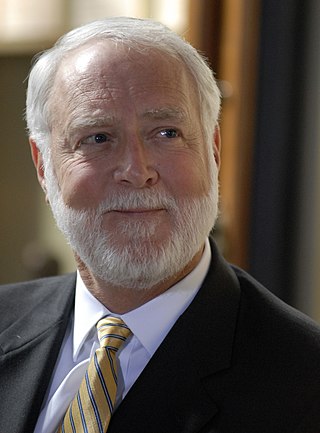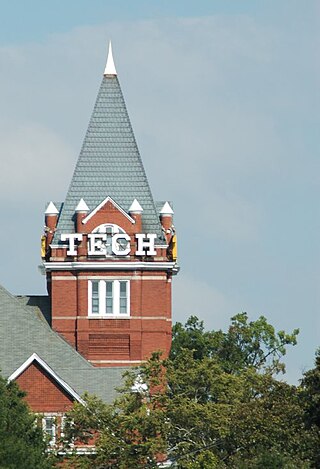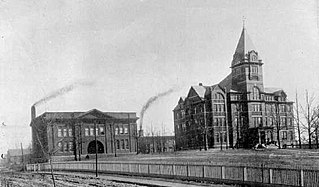
Southern Polytechnic State University was a public, co-educational, state university in Marietta, Georgia, United States approximately 20 miles (32 km) northwest of downtown Atlanta. Until 2015, it was an independent part of the University System of Georgia and called itself "Georgia's Technology University."

Georgia Southern University is a public research university in the U.S. state of Georgia. The flagship campus is in Statesboro, with additional campuses in Savannah and Hinesville. Founded in 1906, Georgia Southern is the fifth-largest institution in the University System of Georgia. Southern offers over 140 different academic majors in the bachelor's, master's, and doctoral levels. The university has a combined enrollment of approximately 27,000 students from all 50 states and over 80 countries. Georgia Southern is classified among "R2: Doctoral Universities – High research activity" and a comprehensive university by the University System of Georgia.

Gerald Wayne Clough is President Emeritus of the Georgia Institute of Technology and former Secretary of the Smithsonian Institution. A graduate of Georgia Tech in civil engineering, he was the first alumnus to serve as President of the Institute.

Technology Square, commonly called Tech Square, is a multi-block neighborhood located in Midtown Atlanta, Georgia, United States. Tech Square is bounded by 8th Street on the north, 3rd Street on the south, West Peachtree Street to the east, and Williams Street to the west. Tech Square includes several academic buildings affiliated with Georgia Tech and provides access to the campus via the Fifth Street Pedestrian Plaza Bridge, reconstructed in 2007. It also contains restaurants, retail shops, condominiums, office buildings, and a hotel.
The Georgia Tech Research Institute (GTRI) is the nonprofit applied research arm of the Georgia Institute of Technology in Atlanta, Georgia, United States. GTRI employs around 3,000 people, and is involved in approximately $800 million in research annually for more than 200 clients in industry and government.

Mac Nease Baseball Park at Russ Chandler Stadium is a college baseball stadium in Atlanta, Georgia. It has been the home field of the Georgia Tech Yellow Jackets college baseball team since 1930. The current stadium opened in 2002.

The Marcus Nanotechnology Building (MNB) is a Georgia Institute of Technology facility. The building was constructed on the site of the Electronics Research Building, the former home of GTRI's Information and Communications Laboratory. It was opened on April 24, 2009, as the Marcus Nanotechnology Research Center, a name it held until October 2013.

The Georgia Tech Campus Recreation Center is part of the Georgia Tech campus.
The College of Design at the Georgia Institute of Technology, established in 1908 as the Department of Architecture and also formerly called the College of Architecture, offered the first four-year course of study in architecture in the Southern United States.

The College of Computing is a college of the Georgia Institute of Technology, a public research university in Atlanta, Georgia. It is divided into four schools: the School of Computer Science, the School of Interactive Computing, the School of Computational Science & Engineering, and the School of Cybersecurity and Privacy. The College of Computing's programs are consistently ranked among the top 10 computing programs in the nation. In 2022, U.S. News & World Report ranked the Computer Science graduate program #6 in the U.S. In 2016, Times Higher Education and the Wall Street Journal ranked the College #5 in the world.

Numerous Georgia Tech legends and traditions have been established since the school's opening in 1888, some of which have persisted for decades. Over time, the school has grown from a trade school into a large research university, and the traditions reflect that heritage. One of the cherished holdovers from Tech's early years, a steam whistle blows every weekday at various times to mark the changing of classes. It's for this reason that the faculty newspaper is named The Whistle.

The history of the Georgia Institute of Technology can be traced back to Reconstruction-era plans to develop the industrial base of the Southern United States. Founded on October 13, 1885, in Atlanta as the Georgia School of Technology, the university opened in 1888 after the construction of Tech Tower and a shop building and only offered one degree in mechanical engineering. By 1901, degrees in electrical, civil, textile, and chemical engineering were also offered. In 1948, the name was changed to the Georgia Institute of Technology to reflect its evolution from an engineering school to a full technical institute and research university.

Kennesaw State University (KSU) is a public research university in the state of Georgia with two campuses in the Atlanta metropolitan area, one in Kennesaw and the other in Marietta on a combined 581 acres (235 ha) of land. The school was founded in 1963 by the Georgia Board of Regents using local bonds and a federal space-grant during a time of major Georgia economic expansion after World War II. KSU also holds classes at the Cobb Galleria Centre, Dalton State College, and in Paulding County (Dallas). The total enrollment exceeds 45,000 students making KSU the third-largest university by enrollment in Georgia.

Georgia Tech Savannah is a satellite campus of the Atlanta-based Georgia Institute of Technology. It is located in Savannah, Georgia, near Savannah/Hilton Head International Airport. The campus is the institute's hub for professional and continuing education and is home to the regional offices of the Georgia Tech Enterprise Innovation Institute, the Savannah Advanced Technology Development Center, and the Georgia Logistics Innovation Center.
The School of Computer Science is an academic unit located within the College of Computing at the Georgia Institute of Technology. It conducts both research and teaching activities related to computer science at the undergraduate and graduate levels. These activities focus on the roots of the computing discipline, including mathematical foundations and system building principles and practices.

The G. Wayne Clough Undergraduate Learning Commons, commonly referred to by its acronym CULC, is an academic building on the main campus of the Georgia Institute of Technology. The five-story, 220,000 sq ft (20,000 m2) building houses classrooms, science laboratories, academic services, commons areas, and is managed by and connected to the Georgia Tech Library. Named in honor of President Emeritus G. Wayne Clough, the Clough Commons cost $85 million and opened in the fall of 2011.

The Georgia Institute of Technology is a public research university and institute of technology in Atlanta, Georgia. Established in 1885, it is part of the University System of Georgia and has satellite campuses in Savannah, Georgia; Metz, France; Shenzhen, China; and Singapore.

The main campus of the Georgia Institute of Technology occupies part of Midtown Atlanta, primarily bordered by 10th Street to the north, North Avenue to the south, and, with the exception of Tech Square, the Downtown Connector to the East, placing it well in sight of the Atlanta skyline. In 1996, the campus was the site of the athletes' village and a venue for a number of athletic events for the 1996 Summer Olympics. The construction of the Olympic Village, along with subsequent gentrification of the surrounding areas, significantly changed the campus.


















